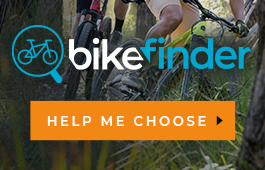Different Styles of Pedal
Find out about the different types of pedals and their intended use in this article.
There are three main types of pedals, Flat Pedals, Mountain Bike Clipless, and Road Clipless. There are many arguments as to which is better. However, it depends on your riding and the bike you are using. Let’s go through each pedal style so you can decide which will suit you.
FLAT PEDALS
Flat pedals are the most common pedals found on bikes due to their versatility and ease of use. There are no specific shoes needed on commuter bikes, and you don't have to worry about the chance of an embarrassing fall at the lights. There are different types of flat pedals, but they are all based around the same premise.
.jpg)
Commuter flat pedals are usually a plastic or composite platform with smaller pins. Some pedals designed around city riding forgo the pins completely and use "Grip Tape" to retain traction. They use lighter forms of retention to protect your shoes from excessive wear or damage. The only downside is they become slippery in wet weather as the pins don't hold your feet as much.
.jpg) .
.
When riding rough trails with rocks and roots everywhere, your feet will get bounced around on the pedals. Because of this, Mountain bike flat pedals have a much larger surface area on the platform and bigger pins for extra grip. They are also an alloy platform for extra durability and strength. They are often getting smashed against rocks or obstacles.
While they work well with everyday runners or casual shoes, specific shoes add even more grip when using these pedals. These particular shoes have extra-soft soles and burlier uppers, so they don't get destroyed quickly. They are also more weather resistant to prevent the elements from destroying your feet.
(3).jpg) .
.
Mountain bike pedals can be used for extra grip when city riding, but, as mentioned above, they may damage the sole of some shoes. The extra grip and comfort of the bigger platform will benefit you if it is raining. It is highly advised against using plastic city pedals for mountain biking because one pedal slip or broken pedal can result in a serious injury.
MTB CLIPLESS PEDALS
Even though you clip into this pedal style, they are called clipless because they secure your foot to the pedal without a “Toe Clip.” Instead, they use a cleat on the bottom of a specially designed shoe and a clamp on the pedal to secure your foot to the pedal. The big benefits of these pedals are security on rough terrain, increased efficiency, and a better sense of connection with the bike.
(2).jpg)
Mountain bike Clipless uses a smaller cleat than the road bike style. The cleats can be recessed into the shoe for extra grip on loose surfaces or pavement. Some shoes even have spiked soles for even more traction in super loose terrain. The smaller cleats also collect less mud and debris. Each brand of MTB clipless shoe uses its own style of cleat, so it is important to check what sort you need before purchasing.
(1).jpg) .
.
The main reason clips are used for Mountain Bikes is for increased retention on rough terrain. When pedaling on rough terrain using flat pedals, your feet can bounce off while moving. Thanks to your foot being physically attached to the pedal, this issue disappears.
(2).jpg)
Because you are physically connected to the bike at another point, it is easier to pick the bike up and pump through the terrain with confidence. The one downside is they can take a while to get used to, and unclipping maybe a little dangerous. We recommend practicing leaned against a wall before hitting the trails.
Mountain Style clipless pedals are the most common clips for city riding as the clips can be recessed into a normal-looking shoe. Walking in road clips is extremely awkward and slippery on tiles or wet surfaces. Smaller cleats recessed into the sole of a shoe leave more rubber to contact the ground for extra grip. You get all the benefits of cleats without the downsides.
.jpg) .
.
Mountain bike cleats are perfect for mountain biking, commuting and even on the road bike. They are very versatile and the most common style of the clipless pedal. However, be aware that if you bolt these cleats onto a flat-soled road shoe, they will be very slippery. The smaller cleat also has a smaller area for power delivery, so they can be less efficient in road sprints than a road-specific cleat.
.jpg)
ROAD CLIPLESS PEDALS
Road cleats are designed to be as light as possible while being optimised for power transfer. The pedal itself is very minimal and can't be ridden in normal shoes. Road shoes are also light and often quite stiff to reduce power loss.
.jpg) .
.
The cleats are often plastic with a rubber coating for increased grip while walking. They are bigger than mountain bike cleats, so they provide a bigger platform under your feet. They are rarely used on dirt or in terrible conditions, so they aren't great for shedding debris. Because they are plastic, they will get destroyed quickly when walking on rough terrain.
.jpg)
Road clip pedals are a bit harder to clip into when in a rush, so they can be dangerous in circumstances where you need to clip in and out often. The pedals can be made of alloy, composite, or carbon fiber. Alloy pedals are reasonably lightweight while being extremely durable. Composite pedals are lighter and cheaper than alloy; however, they aren't as durable. Carbon pedals are soft, strong and stiff for the ultimate performance or durability, but they come at a cost.
Road Clipless pedals are specific pieces of equipment for road riding. We recommend that they aren't used if you are unsure about clipping in. They take a while to get used to as they aren't great for walking in. If your commute or daily needs include a lot of walking or unclipping, then we recommend MTB clips when available.
.jpg) .
.
SETTING UP
Setting up your cleats is a serious part of a bike's fit, especially on a road bike when you are in the same position for hours. Incorrect cleat positioning can lead to inefficiency or even injuries. We recommend following us on setting up your cleats guide or seeing a bike fitter if needed.
If you are unsure about what pedals you require, make sure you reach out to any of our experienced customer service teams. We want to ensure your ride is perfect and as enjoyable as possible. If you want to learn more about your bike setup and components, click here.
 AUS
AUS USA
USA




.jpg)














.jpg)










